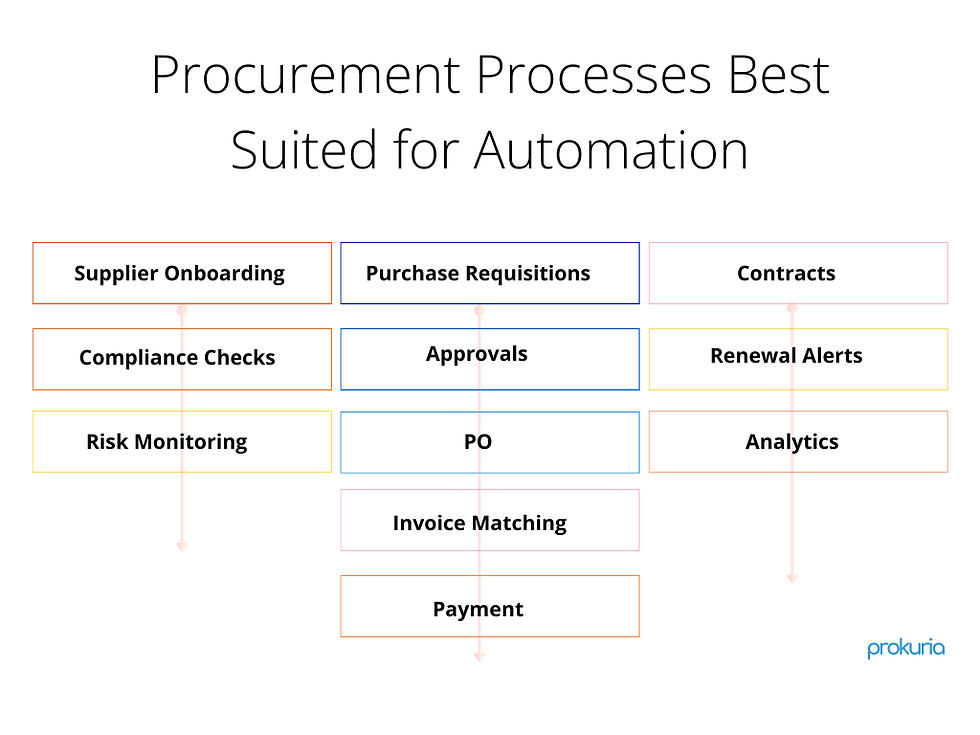The Advantages of Procurement Process Automation
- Robert

- Sep 22
- 5 min read
Updated: Sep 23

Table of contents
In case you don't have the time to read the article in its entirety, here's a quick summary to help you out:
Today, procurement goes far beyond just buying goods or services. It’s about strategy, controlling costs, building strong supplier relationships, promoting sustainability, and managing risks. Sticking to manual processes like paperwork and emails is holding procurement teams back.
Automation is no longer a nice-to-have; it’s a must. Since procurement teams are judged on how well they reduce costs while increasing value, ensuring a steady, cost-effective supply is more important than ever.
In this article, we’ll explore what procurement automation really means today - what’s improved, what’s effective, and what challenges you should be aware of.
What Is Procurement Process Automation?
Procurement automation means using digital tools - software, AI, and process workflows - to handle repetitive and complex procurement tasks that were once manual. Instead of relying on spreadsheets, PDFs, and endless emails, automation standardizes and streamlines the full lifecycle:
Requisitions & approvals with automatic routing, notifications, and escalations.
Purchase orders & invoices with three-way matching and anomaly detection.
Supplier management through portals, digital onboarding, and compliance checks.
Contracts with AI-assisted drafting, clause reviews, and renewal reminders.
Spend analysis & forecasting via real-time dashboards and predictive analytics.
Automation isn’t just about efficiency. It’s about intelligence, risk management, and strategic alignment with ESG and compliance goals.
Key Benefits of Automation (Now & Going Forward)
The biggest change since a few years ago? Automation now provides insight, not just speed -helping procurement become more strategic. So why are leading organizations investing heavily in procurement automation? Because it transforms procurement from a back-office function into a strategic engine.
Cycle times are dramatically shorter. What used to take weeks of approvals and follow-ups now happens in hours, sometimes minutes, because workflows are routed automatically to the right people, no matter where they are.
Visibility has improved beyond recognition. Instead of waiting for month-end reports, procurement leaders can see real-time spend dashboards. That means spotting maverick spend as it happens, comparing suppliers across categories instantly, and making data-driven decisions on the fly.
Supplier collaboration also looks different. Portals give suppliers control over their own data, documents, and invoices, reducing miscommunication and freeing procurement teams from chasing updates.
Contract management has gone from reactive to proactive. Automated reminders prevent renewals from slipping through the cracks, and AI tools highlight risky clauses before they’re signed.
And of course, there are the cost savings. Organizations using automation not only negotiate better but also avoid unnecessary losses - duplicate invoices, late payment fees, and missed discounts that used to quietly drain budgets.
The net result? Procurement teams spend less time fighting fires and more time building strategy.
Which Procurement Processes Can / Should Be Automated

Not every process needs automation at once, but the following are proven to deliver results:
Purchase Requests & Approvals → automated routing with mobile approval options.
Invoice Processing & Payments → faster, more accurate three-way matching.
Contract Lifecycle Management (CLM) → templates, auto-renewals, and AI-based risk detection.
Supplier Onboarding & Due Diligence → digital portals, compliance checks, ESG data collection.
Spend Analytics & Reporting → category-level dashboards, predictive forecasting.
Risk & Compliance Monitoring → financial solvency checks, sanctions lists, ethical compliance.
Starting here builds a solid foundation before moving into more advanced automation.
How to Get Started: Practical Tips
The temptation is to roll out automation across everything at once. But the teams that succeed usually take a phased approach.
First, map your current processes honestly. Not the version you wish you had, but the reality-where delays happen, who gets stuck waiting, and how many approvals pile up.
Then, prioritize. High-volume, low-judgment tasks are the best starting points because the benefits are immediate and visible. Think invoice matching or PO approvals, not complex strategic sourcing.
Data cleanup is another critical step. Automation magnifies errors, so supplier lists, contract terms, and codes need to be standardized before rollout.
And don’t forget your suppliers. They’re part of the system, and adoption will fail if they aren’t onboarded properly. Communication, training, and support matter as much as the technology itself.
Finally, measure progress. Approval cycle time, cost savings, and compliance rates are good benchmarks. Start small, track results, and build from there.
What to Watch Out For / Challenges
Here’s the truth: automation isn’t magic. It comes with its own set of challenges.
People naturally resist change. If teams don’t see value quickly, adoption can stall. Over-automation is another trap - some tasks require human judgment, and forcing them through rigid workflows creates frustration.
Dirty data is a hidden killer. If supplier information is inconsistent, automation will simply replicate the errors faster.
Legacy systems also complicate integrations, and connecting old ERP platforms with new tools takes time and money.
Security is a growing concern. Procurement deals with sensitive financial and supplier data, and compliance frameworks like GDPR and CCPA aren’t optional.
And perhaps the hardest part: ROI takes patience. Automation usually pays off, but not overnight. Expect months, not weeks, to see full value.
Knowing these challenges ahead of time is what separates successful rollouts from failed ones.
What’s New / Emerging in 2025 & Beyond
Automation today is not the same as it was five years ago. The shift is from efficiency to intelligence.
Generative AI now drafts contracts, suggests negotiation strategies, and predicts supplier risks.
Hyperautomation blends RPA with AI to create end-to-end workflows with minimal human input. ESG tracking is built into procurement platforms, giving teams instant visibility into supplier diversity, emissions, and ethical practices.
Mobile-first, cloud-native platforms mean managers can approve a PO from their phones while traveling. In some industries, blockchain pilots are emerging for supply chain transparency -pharma, food safety, and luxury goods are early adopters.
The trend is clear: automation isn’t just about doing things faster. It’s about making procurement smarter, more responsible, and more resilient.
Why It Matters Now
Supply chains are unpredictable. Costs are rising. Regulators expect more transparency.
Procurement teams that remain stuck in manual processes will keep losing ground.
What’s improved? Tools are smarter, easier to use, and deeply integrated.
What’s effective? Cycle time reduction, spend visibility, and supplier collaboration.
What’s challenging? Change resistance, data quality, and security.
In short: automation is no longer optional. It’s the foundation for procurement that can adapt to today’s volatility and tomorrow’s demands.
A Plug: Tools That Can Help
Of course, none of this works without the right platform. That’s where Prokuria can make the difference.
Our solution helps procurement teams automate sourcing, supplier management, reverse auctions, and purchase-to-pay workflows - all in one place. It’s flexible enough to fit your existing processes, integrates seamlessly with finance and ERP systems, and adds the intelligence you need to make smarter decisions.
If you’re ready to turn automation from theory into practice, book a demo today.



Comments